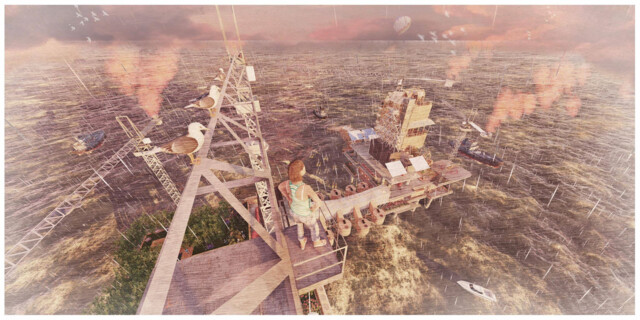- wa-ID
- wa-2028207
- Tag der Veröffentlichung
- 09.01.2020
- Aktualisiert am
- 22.10.2020
- Verfahrensart
- Offener Wettbewerb
- Zulassungsbereich
-
Andere
- Teilnehmer
- Keine Teilnahmebeschränkungen
- Auslober
- UNI - UNIEGIS NETWORK Private Limited
- Bewerbungsschluss
- 27.07.2020
- Abgabetermin
- 28.07.2020
- Preisgerichtssitzung
- 18.08.2020
- Preisgerichtssitzung
- 18.08.-15.09.2020
- Bekanntgabe
- 02.10.2020
Verfahrensart
Offener Ideenwettbewerb
Wettbewerbsaufgabe
Die Öl- und Öl-Gas-Plattformen, von denen es bis vor einigen Jahrzehnten mehr als 8000 auf der ganzen Welt gab, wurden nach und nach abgebaut, um die Meere von der starken Verschmutzung zu befreien, die sie verursachen. Der so genannte Stilllegungsprozess von ortsfesten Plattformen erfolgt in der Regel dadurch, dass sie vollständig aus der Meeresumwelt, in der sie sich befinden, entfernt, auf den Boden gebracht und dann abgerissen oder zerlegt werden, um wertvolle Ausrüstung zu verkaufen oder in einigen Fällen die besten Stücke für eine spätere Wiederverwendung in anderen Bereichen umzubauen.
Als Offshore-Siedlungen stellen diese Art von Strukturen aufgrund ihrer starken visuellen und evokativen Wirkung ein hervorragendes Beispiel für Industriearchäologie in jeder Hinsicht dar, von denen jedoch nur in seltenen Fällen bekannt ist, dass sie als künstliche Inseln in Räume der zivilen Architektur umgewandelt wurden.
Trotz der umweltpolitischen Konflikte, die sie heute konstituieren, ist es unbestreitbar, dass sie aus landschaftsarchitektonischer Sicht eine große visuelle Kraft besitzen und eine Art punktuelle Überhöhung der Horizontlinie darstellen.
Eines der größten Probleme bei der Demontage dieser Strukturen sind die Kosten. Jüngste Studien haben bestätigt, dass die Wiederverwendung und die Sanierung viel billiger sind als z.B. ein kompletter Neubau und teilweise sogar wirtschaftlicher im Hinblick auf den Wiederverkauf der demontierten Teile.
Aufgabe - Wiederverwendung einer Ölplattform, die von ihrer ursprünglichen Funktion zurückgewiesen wurde: Schaffung eines Museums der Offenen Gewässer
Der Zweck dieses Wettbewerbs ist die zukünftige Nutzung von Industriestrukturen, die ihre ursprüngliche Funktion verloren haben, in der Vorstellung, dass in sehr naher Zukunft Öl und seine Derivate hoffentlich vollständig durch erneuerbare Energien ersetzt werden, die allen Menschen zur Verfügung stehen. Das Konzept des Offshore-Bereichs muss viel mehr zu einem Zwischenkonzept werden, wie z.B. das Vorland, um fließende Übergangsarchitekturen in Bezug auf Räume und Funktionen zu schaffen. Auf diese Weise wird das Wasser, das Meer, zum Leitmotiv für die Schaffung eines Wassermuseums, das sich auf die drei Hauptaspekte des Meeres konzentriert: Das Meer als das Meer der Ferne, das Mittelmeer als das Meer der Nähe und die Adria als das Meer der Intimität.
Dieses Museum ist nur für temporäre Ausstellungen, Workshops, Installationen gedacht, aber vor allem muss der Raum selbst die oben gezeigten Metaphern des Meeres widerspiegeln. Es wird auch mit einem kleinen Häuserblock für kurze Aufenthalte interagieren müssen, der von Künstlern, Studenten, Meeresbiologen und Flüchtlingen als integraler Bestandteil der Geschichte des Meeres genutzt werden soll.
Competition assignment
The oil and oil-gas platforms, more than 8000 present all over the planet until a few decades ago, have gradually been dismantled to free the seas from the strong pollution they cause. The so-called decommissioning process of fixed platforms is usually carried out by removing them entirely from the marine environment in which they are located, bringing them to the ground and then demolishing or disassembling them to sell valuable equipment or, in some cases, revamping the best pieces for later reuse in other fields.
As offshore settlements, these kinds of structures, due to their strong visual and evocative impact, constitute an excellent example of industrial archaeology in any sense which, however, only in rare cases have been known to be converted into spaces of civil architecture as artificial islands.
Despite the environmental political conflicts that they constitute nowadays, it is undeniable that from an architectural landscape point of view they have great visual strength and constitute a kind of punctual exaltation of the horizon line.
One of the biggest problems caused by the dismantling of these structures is the costs. Recent studies have validated that re-use and redevelopment are much cheaper than, for example, completely new construction and partly even more economical in reference to the resale of disassembled parts.
Brief - Reuse an Oil platform dismissed by its original function: Creation of a Museum of Open Waters
The purpose of this competition is the future use of industrial structures that have lost their original function, imagining that in the very near future oil and its derivatives will hopefully be replaced completely by renewable energy available to all people. The concept of offshore must become much more an intermediate concept such as the foreshore in order to create fluid transition architectures in terms of spaces and functions. In this way, the water, the sea, becomes the leitmotif for the creation of a water museum focused on the three main aspects of the sea: The ocean as the sea of the distance, The Mediterranean for proximity and The Adriatic as the sea of intimacy.
This museum is only for temporary exhibitions, Workshops, installation but above all the space itself must reflect the metaphors of the sea shown above. It will also have to interact with a small block of houses for short stays, for use by artists, students, marine biologists and refugees as an integral part of the history of the sea.
Preisgericht / Jury
Yannis Graos, CEO, Yannis Graos Architects + Engineers, Greece
Antonello Marotta, Architect, Writer and Researcher (PhD), Department of architecture, University of Sassari, Italy
Yuri Avvakumov, Principal Architect, Studio Agitarch, Russia
Massimiliano Ercolani, Architect and Artist, DoKC Lab / Ercolani Bros., Italy
Donatella Cusma, Co-Founder, principal, Claret-Cup, USA
Offener Ideenwettbewerb
Wettbewerbsaufgabe
Die Öl- und Öl-Gas-Plattformen, von denen es bis vor einigen Jahrzehnten mehr als 8000 auf der ganzen Welt gab, wurden nach und nach abgebaut, um die Meere von der starken Verschmutzung zu befreien, die sie verursachen. Der so genannte Stilllegungsprozess von ortsfesten Plattformen erfolgt in der Regel dadurch, dass sie vollständig aus der Meeresumwelt, in der sie sich befinden, entfernt, auf den Boden gebracht und dann abgerissen oder zerlegt werden, um wertvolle Ausrüstung zu verkaufen oder in einigen Fällen die besten Stücke für eine spätere Wiederverwendung in anderen Bereichen umzubauen.
Als Offshore-Siedlungen stellen diese Art von Strukturen aufgrund ihrer starken visuellen und evokativen Wirkung ein hervorragendes Beispiel für Industriearchäologie in jeder Hinsicht dar, von denen jedoch nur in seltenen Fällen bekannt ist, dass sie als künstliche Inseln in Räume der zivilen Architektur umgewandelt wurden.
Trotz der umweltpolitischen Konflikte, die sie heute konstituieren, ist es unbestreitbar, dass sie aus landschaftsarchitektonischer Sicht eine große visuelle Kraft besitzen und eine Art punktuelle Überhöhung der Horizontlinie darstellen.
Eines der größten Probleme bei der Demontage dieser Strukturen sind die Kosten. Jüngste Studien haben bestätigt, dass die Wiederverwendung und die Sanierung viel billiger sind als z.B. ein kompletter Neubau und teilweise sogar wirtschaftlicher im Hinblick auf den Wiederverkauf der demontierten Teile.
Aufgabe - Wiederverwendung einer Ölplattform, die von ihrer ursprünglichen Funktion zurückgewiesen wurde: Schaffung eines Museums der Offenen Gewässer
Der Zweck dieses Wettbewerbs ist die zukünftige Nutzung von Industriestrukturen, die ihre ursprüngliche Funktion verloren haben, in der Vorstellung, dass in sehr naher Zukunft Öl und seine Derivate hoffentlich vollständig durch erneuerbare Energien ersetzt werden, die allen Menschen zur Verfügung stehen. Das Konzept des Offshore-Bereichs muss viel mehr zu einem Zwischenkonzept werden, wie z.B. das Vorland, um fließende Übergangsarchitekturen in Bezug auf Räume und Funktionen zu schaffen. Auf diese Weise wird das Wasser, das Meer, zum Leitmotiv für die Schaffung eines Wassermuseums, das sich auf die drei Hauptaspekte des Meeres konzentriert: Das Meer als das Meer der Ferne, das Mittelmeer als das Meer der Nähe und die Adria als das Meer der Intimität.
Dieses Museum ist nur für temporäre Ausstellungen, Workshops, Installationen gedacht, aber vor allem muss der Raum selbst die oben gezeigten Metaphern des Meeres widerspiegeln. Es wird auch mit einem kleinen Häuserblock für kurze Aufenthalte interagieren müssen, der von Künstlern, Studenten, Meeresbiologen und Flüchtlingen als integraler Bestandteil der Geschichte des Meeres genutzt werden soll.
Competition assignment
The oil and oil-gas platforms, more than 8000 present all over the planet until a few decades ago, have gradually been dismantled to free the seas from the strong pollution they cause. The so-called decommissioning process of fixed platforms is usually carried out by removing them entirely from the marine environment in which they are located, bringing them to the ground and then demolishing or disassembling them to sell valuable equipment or, in some cases, revamping the best pieces for later reuse in other fields.
As offshore settlements, these kinds of structures, due to their strong visual and evocative impact, constitute an excellent example of industrial archaeology in any sense which, however, only in rare cases have been known to be converted into spaces of civil architecture as artificial islands.
Despite the environmental political conflicts that they constitute nowadays, it is undeniable that from an architectural landscape point of view they have great visual strength and constitute a kind of punctual exaltation of the horizon line.
One of the biggest problems caused by the dismantling of these structures is the costs. Recent studies have validated that re-use and redevelopment are much cheaper than, for example, completely new construction and partly even more economical in reference to the resale of disassembled parts.
Brief - Reuse an Oil platform dismissed by its original function: Creation of a Museum of Open Waters
The purpose of this competition is the future use of industrial structures that have lost their original function, imagining that in the very near future oil and its derivatives will hopefully be replaced completely by renewable energy available to all people. The concept of offshore must become much more an intermediate concept such as the foreshore in order to create fluid transition architectures in terms of spaces and functions. In this way, the water, the sea, becomes the leitmotif for the creation of a water museum focused on the three main aspects of the sea: The ocean as the sea of the distance, The Mediterranean for proximity and The Adriatic as the sea of intimacy.
This museum is only for temporary exhibitions, Workshops, installation but above all the space itself must reflect the metaphors of the sea shown above. It will also have to interact with a small block of houses for short stays, for use by artists, students, marine biologists and refugees as an integral part of the history of the sea.
Preisgericht / Jury
Yannis Graos, CEO, Yannis Graos Architects + Engineers, Greece
Antonello Marotta, Architect, Writer and Researcher (PhD), Department of architecture, University of Sassari, Italy
Yuri Avvakumov, Principal Architect, Studio Agitarch, Russia
Massimiliano Ercolani, Architect and Artist, DoKC Lab / Ercolani Bros., Italy
Donatella Cusma, Co-Founder, principal, Claret-Cup, USA
Proximity Island – Architectural Ideas for Repurposing Oil rigs
Organizers
UNI, UNIEGIS NETWORK Private Limited, New Delhi
competitions.uni.xyz
Overview
The oil and oil-gas platforms, more than 8000 present all over the planet until a few decades ago, have gradually been dismantled to free the seas from the strong pollution they cause. The so-called decommissioning process of fixed platforms is usually carried out by removing them entirely from the marine environment in which they are located, bringing them to the ground and then demolishing or disassembling them to sell valuable equipment or, in some cases, revamping the best pieces for later reuse in other fields.
As offshore settlements, these kinds of structures, due to their strong visual and evocative impact, constitute an excellent example of industrial archaeology in any sense which, however, only in rare cases have been known to be converted into spaces of civil architecture as artificial islands.
Despite the environmental political conflicts that they constitute nowadays, it is undeniable that from an architectural landscape point of view they have great visual strength and constitute a kind of punctual exaltation of the horizon line.
One of the biggest problems caused by the dismantling of these structures is the costs. Recent studies have validated that re-use and redevelopment are much cheaper than, for example, completely new construction and partly even more economical in reference to the resale of disassembled parts.
Brief - Reuse an Oil platform dismissed by its original function: Creation of a Museum of Open Waters
The purpose of this competition is the future use of industrial structures that have lost their original function, imagining that in the very near future oil and its derivatives will hopefully be replaced completely by renewable energy available to all people. The concept of offshore must become much more an intermediate concept such as the foreshore in order to create fluid transition architectures in terms of spaces and functions. In this way, the water, the sea, becomes the leitmotif for the creation of a water museum focused on the three main aspects of the sea: The ocean as the sea of the distance, The Mediterranean for proximity and The Adriatic as the sea of intimacy.
This museum is only for temporary exhibitions, Workshops, installation but above all the space itself must reflect the metaphors of the sea shown above. It will also have to interact with a small block of houses for short stays, for use by artists, students, marine biologists and refugees as an integral part of the history of the sea.
Competition Type
Open ideas competition
Admission Area
International
Eligibility
Minimum eligible age for participation is 18 years.
There is no restriction to the degree or design disciplines to participate in the challenge.
Participation in the competition can happen in a team as well as an individual.
Maximum numbers of participants in a team are 4.
The challenge is open worldwide for anyone to participate.
Schedule
Registration ends: May 05, 2020
Submission ends: May 15, 2020
Shortlist entries announced: May 25, 2020
Jury evaluation: May 25 – June 15, 2020
Public voting ends: June 15, 2020
Results announcement: June 25, 2020
More information and documents at
competitions.uni.xyz/proximity-island
Organizers
UNI, UNIEGIS NETWORK Private Limited, New Delhi
competitions.uni.xyz
Overview
The oil and oil-gas platforms, more than 8000 present all over the planet until a few decades ago, have gradually been dismantled to free the seas from the strong pollution they cause. The so-called decommissioning process of fixed platforms is usually carried out by removing them entirely from the marine environment in which they are located, bringing them to the ground and then demolishing or disassembling them to sell valuable equipment or, in some cases, revamping the best pieces for later reuse in other fields.
As offshore settlements, these kinds of structures, due to their strong visual and evocative impact, constitute an excellent example of industrial archaeology in any sense which, however, only in rare cases have been known to be converted into spaces of civil architecture as artificial islands.
Despite the environmental political conflicts that they constitute nowadays, it is undeniable that from an architectural landscape point of view they have great visual strength and constitute a kind of punctual exaltation of the horizon line.
One of the biggest problems caused by the dismantling of these structures is the costs. Recent studies have validated that re-use and redevelopment are much cheaper than, for example, completely new construction and partly even more economical in reference to the resale of disassembled parts.
Brief - Reuse an Oil platform dismissed by its original function: Creation of a Museum of Open Waters
The purpose of this competition is the future use of industrial structures that have lost their original function, imagining that in the very near future oil and its derivatives will hopefully be replaced completely by renewable energy available to all people. The concept of offshore must become much more an intermediate concept such as the foreshore in order to create fluid transition architectures in terms of spaces and functions. In this way, the water, the sea, becomes the leitmotif for the creation of a water museum focused on the three main aspects of the sea: The ocean as the sea of the distance, The Mediterranean for proximity and The Adriatic as the sea of intimacy.
This museum is only for temporary exhibitions, Workshops, installation but above all the space itself must reflect the metaphors of the sea shown above. It will also have to interact with a small block of houses for short stays, for use by artists, students, marine biologists and refugees as an integral part of the history of the sea.
Competition Type
Open ideas competition
Admission Area
International
Eligibility
Minimum eligible age for participation is 18 years.
There is no restriction to the degree or design disciplines to participate in the challenge.
Participation in the competition can happen in a team as well as an individual.
Maximum numbers of participants in a team are 4.
The challenge is open worldwide for anyone to participate.
Schedule
Registration ends: May 05, 2020
Submission ends: May 15, 2020
Shortlist entries announced: May 25, 2020
Jury evaluation: May 25 – June 15, 2020
Public voting ends: June 15, 2020
Results announcement: June 25, 2020
More information and documents at
competitions.uni.xyz/proximity-island












